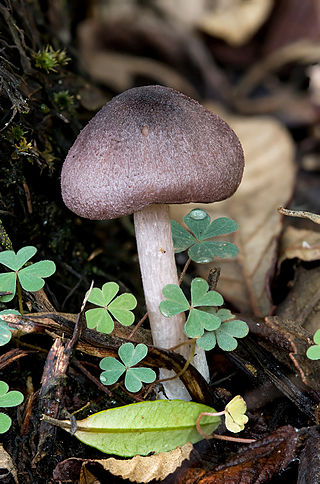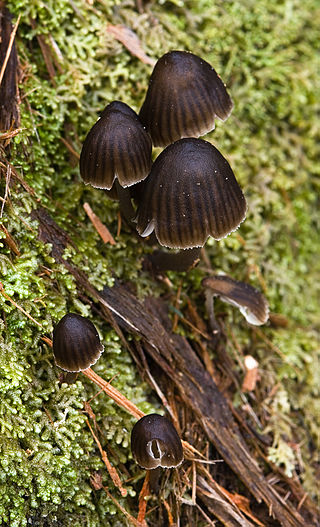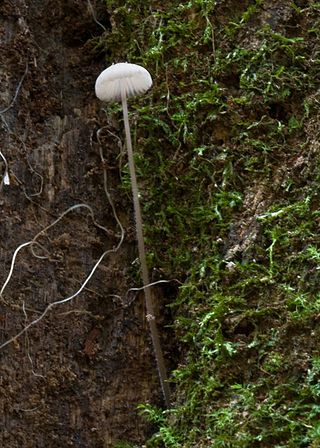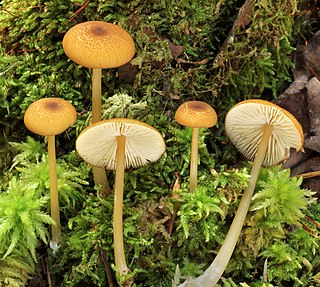Related Research Articles

Entoloma sinuatum is a poisonous mushroom found across Europe and North America. Some guidebooks refer to it by its older scientific names of Entoloma lividum or Rhodophyllus sinuatus. The largest mushroom of the genus of pink-spored fungi known as Entoloma, it is also the type species. Appearing in late summer and autumn, fruit bodies are found in deciduous woodlands on clay or chalky soils, or nearby parklands, sometimes in the form of fairy rings. Solid in shape, they resemble members of the genus Tricholoma. The ivory to light grey-brown cap is up to 20 cm (7.9 in) across with a margin that is rolled inward. The sinuate gills are pale and often yellowish, becoming pink as the spores develop. The thick whitish stem has no ring.

The Fungi of Australia form an enormous and phenomenally diverse group, a huge range of freshwater, marine and terrestrial habitats with many ecological roles, for example as saprobes, parasites and mutualistic symbionts of algae, animals and plants, and as agents of biodeterioration. Where plants produce, and animals consume, the fungi recycle, and as such they ensure the sustainability of ecosystems.

Entoloma is a genus of fungi in the order Agaricales. Called pinkgills in English, basidiocarps are typically agaricoid, though a minority are gasteroid. All have salmon-pink basidiospores which colour the gills at maturity and are angular (polyhedral) under a microscope. The genus is large, with almost 2000 species worldwide. Most species are saprotrophic, but some are ectomycorrhizal, and a few are parasitic on other fungi. The type, Entoloma sinuatum, is one of several Entoloma species that are poisonous, typically causing mild to severe gastrointestinal illness.

The Entolomataceae are a family of fungi in the order Agaricales. The family contains eight genera and 2250 species, the majority of which are in Entoloma. Basidiocarps are typically agaricoid, but a minority are cyphelloid. secotioid, or gasteroid. All produce pink basidiospores that are variously angular (polyhedral), ridged, or nodulose. Species are mostly saprotrophic, though a few are parasitic on other fungi. The family occurs worldwide.
Thomas (Tom) William May is a mycologist at the National Herbarium of Victoria where he specialises in the taxonomy and ecology of Australian macrofungi. He is most notable for the comprehensive bibliographical lists of all Australian fungi published thus far; Volume 2A, published in 1997, and Volume 2B, published in 2003. as well as the originator of Fungimap, an Australia-wide mapping fungal mapping scheme based on observations of 100 easily identified macrofungi. May was awarded the 2014 Australian Natural History Medallion.

Nolanea is a subgenus of fungi in the order Agaricales. Called pinkgills in English, basidiocarps are agaricoid, mostly mycenoid with slender stems. All have salmon-pink basidiospores which colour the gills at maturity and are angular (polyhedral) under a microscope. Recent DNA evidence has shown that at least 87 species belong to the subgenus Nolanea which has a worldwide distribution.

Sarcodon is a genus of fungi in the family Bankeraceae, which is part of the order Thelephorales, known for its almost universal ectomycorrhizal ecology. The genus owes its name to the presence of teeth-like spines on the hymenophore, from ancient Greek; sarco = flesh and odon = tooth. For this reason they are commonly called "tooth fungi", or "Hydnoid fungi".

Cortinarius rotundisporus, also known as the elegant blue webcap, is a basidiomycete mushroom of the genus Cortinarius found in southern Australia, where it is found in eucalypt forests and rainforests. The cap of the fruit body is a steely blue colour, with a yellowish boss, and paler similarly coloured stipe.

Cortinarius archeri is a species of mushroom in the genus Cortinarius native to Australia. The distinctive mushrooms have bright purple caps that glisten with slime, and appear in autumn in eucalypt forests.

Entoloma rodwayi, known as the green stem pinkgill, is a species of fungus in the Entolomataceae family of mushrooms. A yellowish green mushroom with pink gills and spores, it is found in wet forests of Tasmania.

Entoloma austroprunicolor is a species of agaric fungus in the family Entolomataceae. Described as new to science in 2007, it is found in Tasmania, where it fruits on the ground of wet sclerophyll forests in late spring to early winter. The fruit bodies (mushrooms) have reddish-purple caps measuring up to 5 cm (2.0 in) in diameter supported by whitish stipes measuring 3–7.5 cm (1.2–3.0 in) long by 0.2–0.6 cm (0.1–0.2 in) thick. On the cap underside, the crowded gills are initially white before turning pink as the spores mature.

Mycena nargan, commonly known as the Nargan's bonnet, is a species of fungus in the family Mycenaceae, and the sole member of the section Nargan in the genus Mycena. Reported as a new species in 1995, it is known predominantly from Southern Australia. The saprobic fungus produces mushrooms that grow on well-decayed wood, often on the underside of wood lying in litter. The dark chestnut-coloured caps are covered with white, easily removed scales, and reach diameters of up to 2 cm (0.8 in) wide. The pale, slender stems are up to 5 cm (2.0 in) long and have white scales at the base. On the underside of the cap, the cream-coloured gills are widely spaced and bluntly attached to the stem. The edibility of the mushroom is unknown.
Machiel Evert Noordeloos is a Dutch mycologist. He is known for his contributions to the taxonomy of European mushrooms and especially his expertise on the genus Entoloma. Noordeloos is an assistant professor at the Nationaal Herbarium Nederland, and has served as the editor of the mycological journals Persoonia since 1991 and Coolia since 1976. He was in 2011 the editor in chief of Persoonia. He was the recipient of the Clusius Prize awarded by the Hungarian Mycological Society in 2009.

Mycena cystidiosa is a species of mushroom in the family Mycenaceae. Described as new to science in 1964, it is known only from New Zealand and Australia. The fruit bodies have a broadly conical small white cap up to 12 mm (0.5 in) wide, with distantly spaced cream-coloured gills on the underside. The stipe is particularly long, up to 20 cm (8 in), with an abundant covering of white hairs at the base. The species is known for its abundant rhizomorphs—long, root-like extensions of mycelia.

Entoloma mathinnae is a species of agaric fungus in the family Entolomataceae. Known only from Tasmania, Australia, it was described as new to science in 2009. Mushrooms have light yellow-brown, convex caps up to 8 cm (3.1 in) wide atop stems measuring 5–8.5 cm (2.0–3.3 in) long.

Amanita ochrophylla is a fungus of the family Amanitaceae native to southeastern Australia. Its large and distinctive buff fruit bodies are common after rainfall.
Dr Teresa Lebel is a taxonomist and ecologist who works on fungi, with a particular interest in subterranean truffle-like fungi and their mushroom, bolete, bracket or cup relatives.

Entoloma formosum is an inconspicuous yellowish-brown mushroom in the family Entolomataceae which are distinguished by their pink angular spores.
Hydnellum gatesiae is a species of mushroom in the family Bankeraceae. It was described by James K. Douch, Luke J. Vaughan, and Tom W. May in 2024. The specific epithet refers to Genevieve M. Gates, who collected all specimens used in the species description. The type locality is Kermandie Falls, Australia.
References
- 1 2 Gates, Genevieve M. (2009). Coarse woody debris, macrofungal assemblages, and sustainable forest management in a Eucalyptus obliqua forest of southern Tasmania (PhD thesis). University of Tasmania.
- 1 2 3 4 5 6 7 8 "Dr Genevieve Gates". Tasmanian Honour Roll of Women. State Government of Tasmania. Retrieved 12 January 2024.
- ↑ Ratkowsky, D.A.; Gates, G.M. (2002). "A preliminary census of the macrofungi of Mount Wellington, Tasmania- the Agaricales". Papers and Proceedings of the Royal Society of Tasmania. 136: 89–100. doi:10.26749/rstpp.136.89 . Retrieved 12 January 2024.
- 1 2 3 Campbell, Maxwell (2022). "Natural History Medallion: Dr Genevieve Gates". The Victorian Naturalist. 140 (2): 55–57.
- ↑ Noordeloos, M and Gates, G.M. The Entolomataceae of Tasmania. Springer, 2012
- ↑ "Doctor Genevieve Gates". Discover our expertise. University of Tasmania. Retrieved 12 January 2024.
- ↑ "Collection at the Tasmanian Herbarium". Tasmanian Herbarium. Tasmanian Museum and Art Gallery. Retrieved 12 January 2024.
- 1 2 Gates, Genevieve M.; Noordeloos, Machiel (2007). "Preliminary studies in the genus Entoloma in Tasmania -I". Persoonia. 19 (2): 157–226. Retrieved 12 January 2024.
- 1 2 3 4 5 6 7 8 9 10 11 Noordeloos, Machiel; Gates, Genevieve M. (2009). "Preliminary studies in the genus Entoloma in Tasmania -II" (PDF). Cryptogamie, Mycologie. 30 (2): 107–140. Retrieved 12 January 2024.
- ↑ Gates GM, Horton BM, Noordeloos ME (2009). "A new Entoloma (Basidiomycetes, Agaricales) from Tasmania" (PDF). Mycotaxon. 107: 175–9. doi:10.5248/107.175. Archived from the original (PDF) on 2010-02-15.
- ↑ Gasparini, B. (2007-03-01). "Genus Cortinarius, subgenus Phlegmacium in Tasmania". New Zealand Journal of Botany. 45 (1): 155–236. Bibcode:2007NZJB...45..155G. doi: 10.1080/00288250709509711 . ISSN 0028-825X. S2CID 84810334.
- ↑ International Plant Names Index. G.M.Gates.
- ↑ "Occurrence records". Australasian Virtual Herbarium. Atlas of Living Australia. Retrieved 12 January 2024.
- ↑ "Occurrence records". Australasian Virtual Herbarium. Atlas of Living Australia. Retrieved 12 January 2024.
- ↑ "Occurrence records". eElurikkus. University of Tartu Natural History Museum and Botanical Garden. Retrieved 12 January 2024.
- ↑ Liu, S.L.; He, S.H.; Wang, X.W.; May, T.W.; He, G.; Chen, S.L.; Zhou, L.W. (2022). "Trechisporales emended with a segregation of Sistotremastrales ord. nov. (Basidiomycota)" (PDF). Mycosphere. 13 (1): 862–954. doi:10.5943/mycosphere/13/1/11 . Retrieved 12 January 2024.
- ↑ Karstedt, F.; Bergemann, S.E.; Gates, G.; Ratkowsky, D.; Cunha, K.M.; Capelari, M. (2024). "Species of Entoloma (Entolomataceae) with cuboidal basidiospores from Brazil". Phytotaxa. 654 (1): 1–76. doi:10.11646/PHYTOTAXA.654.1.1 . Retrieved 13 September 2024.
- ↑ Douch, J.K.; Vaughan, L.J.; Cooper, J.A.; Holmes, G.D.; Robinson, R.; Stefani, F.; Idnurm, A.; May, T.W. (2024). "Taxonomic revision of fleshy species of Hydnellum, Neosarcodon, and Sarcodon (Thelephorales) from Australasia". Mycosphere. Retrieved 12 September 2024.
- ↑ "Secretary's Report presented at AGM 4th. March 2021". Tasmanian Field Naturalists Club Inc. Archived from the original on 16 June 2023. Retrieved 12 January 2024.
- ↑ "Genevieve Gates Awarded ANHC Medallion". Tasmanian Field Naturalists Club Inc. 6 December 2022. Archived from the original on 30 January 2023. Retrieved 12 January 2024.